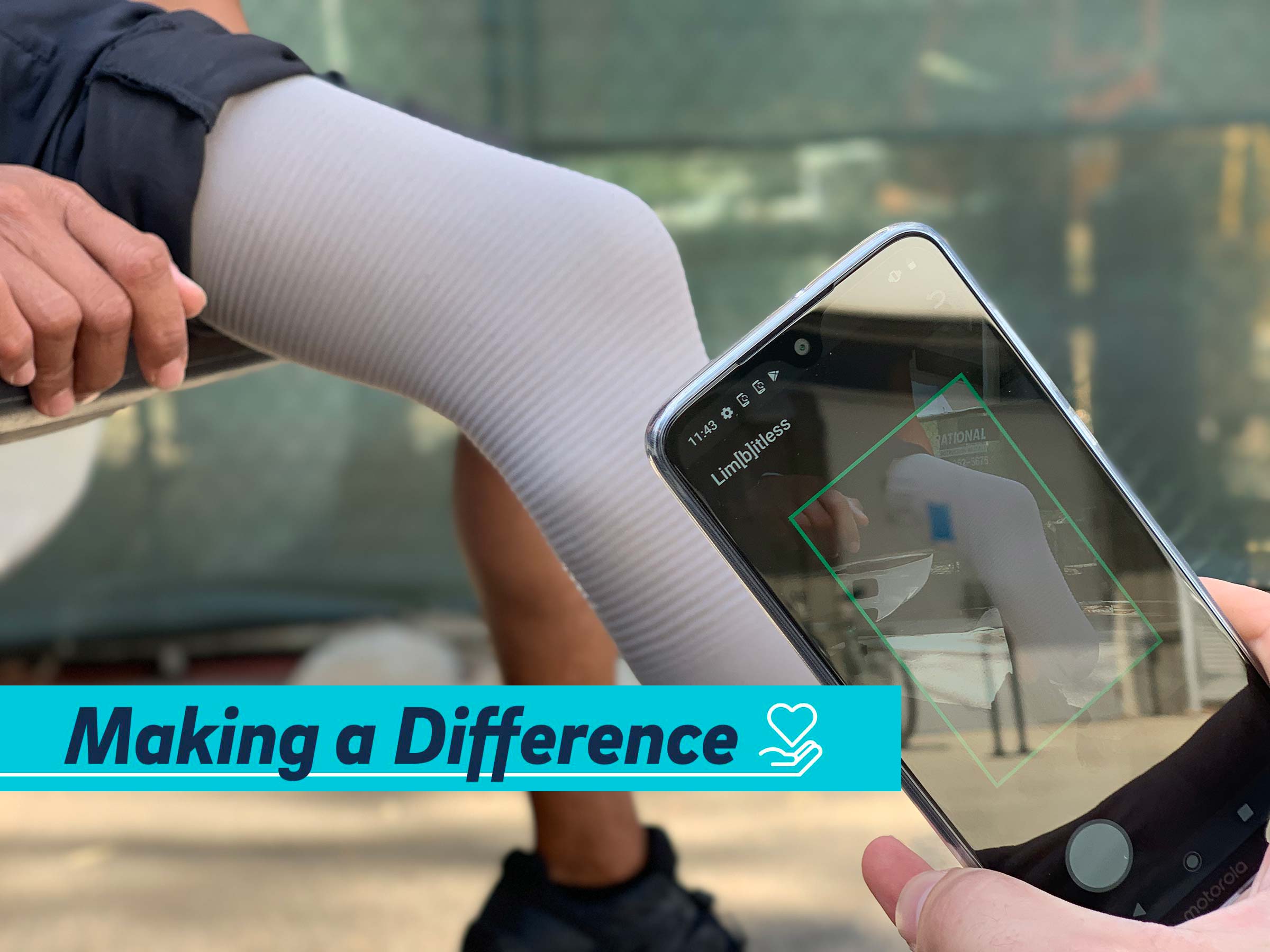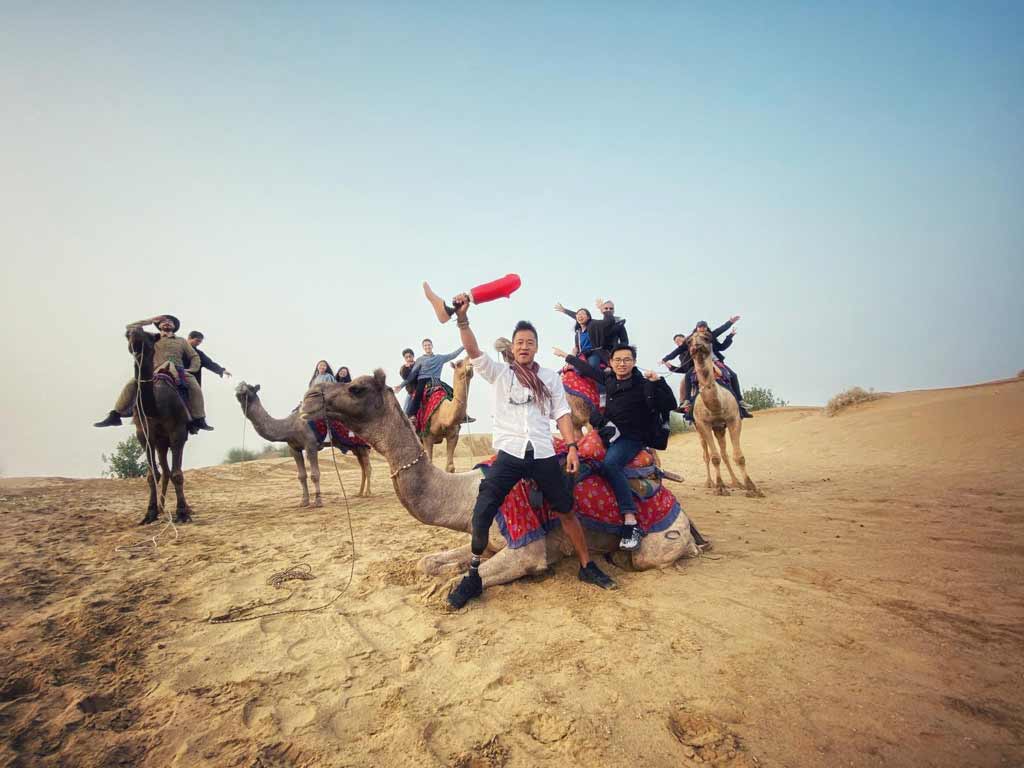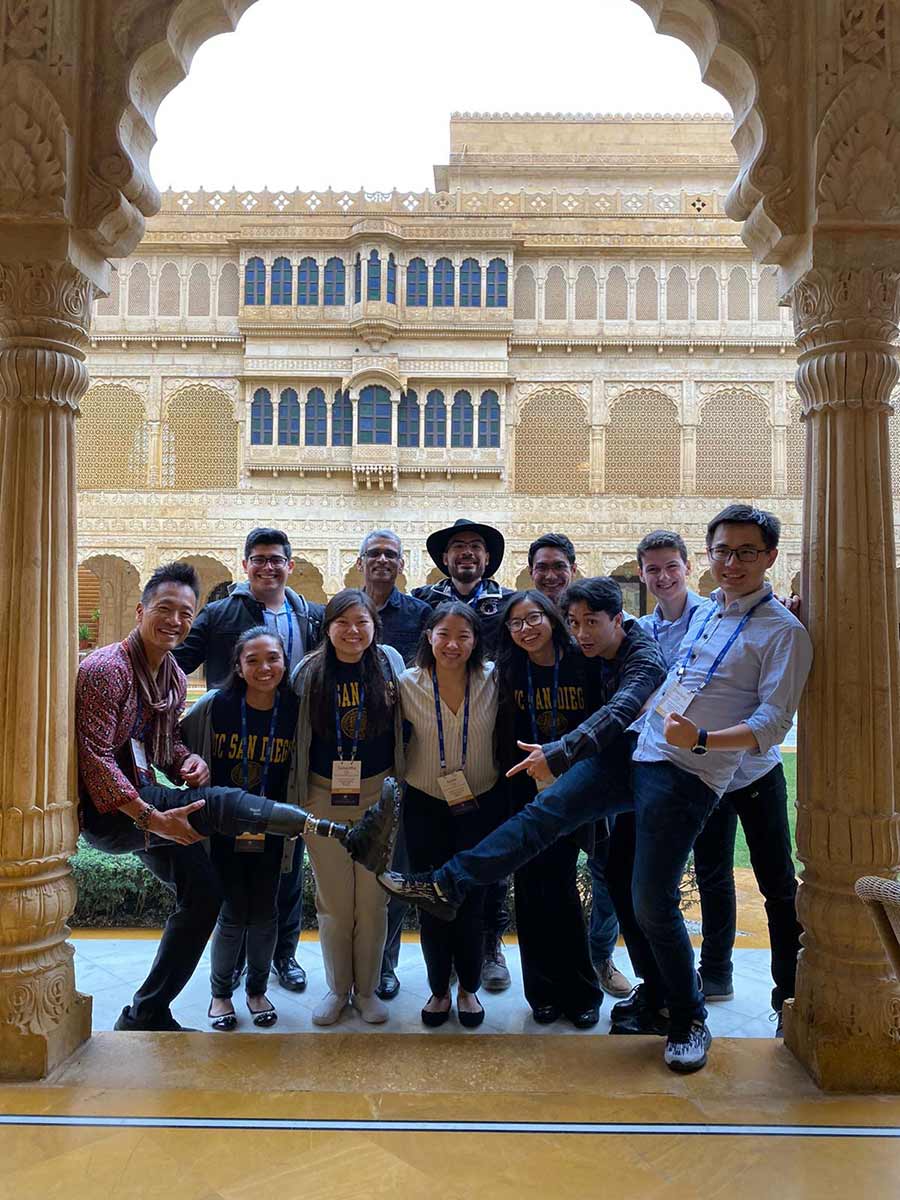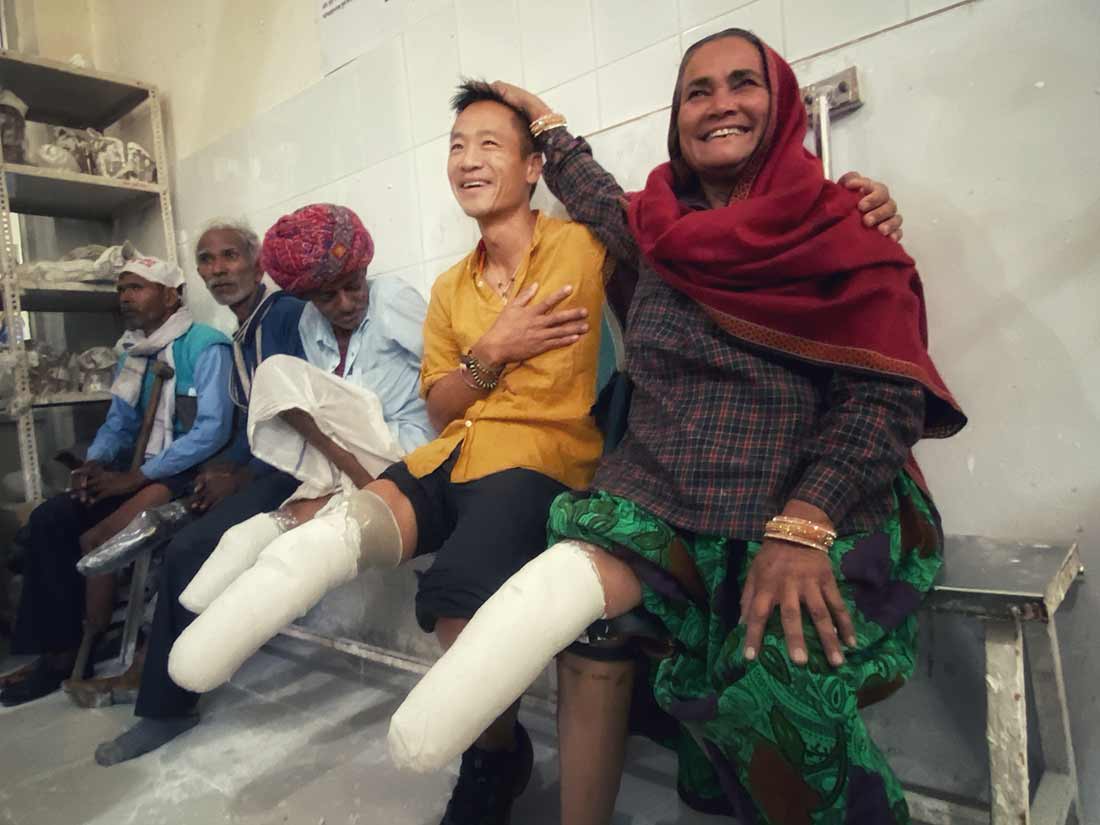
By:
- Xochitl Rojas-Rocha
Published Date
By:
- Xochitl Rojas-Rocha
Share This:
Lim(b)itless in India: UC San Diego Students Travel Abroad to Empower Amputees

The Project Lim(b)itless app creates a 3D digital model of an amputee's residual limb through a process called photogrammetry, an imaging technique Lin has used to map historical sites around the world.
In November, 2019, ten UC San Diego students filed into a bustling amputee clinic in Jaipur, India. On one side of the room, men and women, some bearing crutches, watched as their new limbs took shape under the staff’s careful hands. For many of them, a prosthetic limb represented the chance to regain their mobility, independence and livelihoods.
The students’ visit to the Jaipur Foot clinic—a non-profit known around the world for providing affordable, prosthetic limbs and other mobility aids to those in need—marked more than a year of painstaking work to develop technology connecting amputees directly to prosthetists. The work is part of Project Lim(b)itless, an initiative founded by Albert Lin, a recent amputee and researcher at the Qualcomm Institute (QI) at UC San Diego.
With Lin’s guidance, and led by graduate student Isaac Cabrera, the students created a cellphone app that gives amputees the power to scan their residual limb, send an autonomously-generated 3D model to a prosthetist, and have a custom-built prosthetic delivered right to them. The project has the potential to help organizations like Jaipur Foot reach many more amputees, especially those without the means to travel.
In new territory
Days earlier, the students touched down west of Jaipur in the rural town of Jaisalmer, India. Jet-lagged and exhausted, they rallied together, donned matching team T-shirts and accompanied Lin and Qualcomm Institute Director Ramesh Rao to the November 2019 INK Conference, where Lin presented Project Lim(b)itless. As he spoke to the rapt crowd, Lin wore a bright red, 3D-printed limb created just for him by the students days earlier through the Project Lim(b)itless app.

The students of Project Lim(b)itless pose with Albert Lin and a 3D-printed prosthetic limb in the desert dunes outside Jaisalmer, India.
Cabrera, a Ph.D. candidate and co-leader of the Project Lim(b)itless student team, remembers being thrilled. It had been his dream to bring the team’s students to India, where nearly a million citizens are amputees. He wanted them to witness how their efforts could help people.
“I was incredibly inspired by how motivated, disciplined and determined my students were,” said Cabrera. “They each worked hundreds of hours, including many late nights and weekends, all because they believe that this project has the potential to change the world.”
At Rao’s invitation, Cabrera had shared Project Lim(b)itless at an annual awards ceremony for the Mahatma Ghandi Memorial Scholarship earlier that fall. His request touched many in the audience and Project Lim(b)itless raised enough money to cover travel funds for the entire student team.
Soon, the students were networking with high-profile individuals, like the Vice President of Google India, and celebrating Lin’s successful presentation at INK. Kaela Wong, a Mechanical Engineering undergraduate and Cabrera’s co-leader, recalls an especially bright moment as Lin danced through the night on the 3D-printed leg she and her teammates had designed.
“It was proof of the power of undergraduate students—everyone in the audience and on the dance floor with Albert was so impressed and moved by our dedication to the project and the amount of progress we have achieved as undergraduates,” she said.
The work begins
Project Lim(b)itless’ student team was born out of the determination of a handful students wanting to make a difference. Inspired by a recent class on 3D-printing, Cabrera, Wong and a few classmates had started their own project designing a prosthetic limb that could be 3D-printed with cost-effective materials. They began working with Lin, who had been involved in an off-roading vehicle accident that ultimately led to the amputation of his right leg below the knee in 2016. At the time of the accident, Lin had been thriving as an engineer, QI innovator and National Geographic explorer. Active and adventurous, he used his background in research to search for hidden markers of civilization buried deep underground, and surfed, ran or rock-climbed during his time off.

he team poses in Jaisalmer. Albert Lin, project lead, stands far left. Ramesh Rao, director of the UC San Diego Qualcomm Institute, stands third from the left, background.
After the loss of his lower leg, Lin struggled with overcoming phantom limb pain and adjusting to life as an amputee. As he learned to use a prosthetic, he began to consider the lives of other amputees around the world. His false limb would allow him to rejoin his old life; what of those who couldn’t?
“I feel this guilt for having access to a prosthetic that lets me have a full life when so many others don’t. So, in a way, I know I have this responsibility to take on the barriers to democratizing that access,” said Lin, founder of the QI Center for Human Frontiers.
Of the approximately 40 million amputees worldwide, only a fraction have access to a prosthetic limb. Multiple office visits, travel fees, and material and labor costs can drive prices into the tens of thousands of dollars.
Lin planned to use an engineering approach to devise a way to lower the cost of prosthetic limbs and remove the need for an amputee (the most immobile population he notes) to travel to a prosthetist for care. He suspected that 3D-printing and nearly-ubiquitous cellphone technology might be the key. In coming across Cabrera and Wong, he’d found the team with the intense drive, curiosity and background needed to make Project Lim(b)itless a reality.
"I have never encountered such a dedicated group of individuals. These students put in countless hours of problem-solving and innovating, purely out of the desire to help others," said Lin. "What's more, they self-organized in a way that describes the best in engineering leadership."
3D-printing the road to India
The Project Lim(b)itless team has continued to expand. Soon after meeting Lin, Cabrera and Wong set about recruiting other students from diverse engineering backgrounds to strengthen their team. Together, these dedicated students helped Lin repurpose photogrammetry—an imaging technique Lin has used to map historical sites in Mexico, China and Guatemala—to create a 3D model of someone’s limb using a cell phone app.
All an amputee needs to do is snap photographs of their limb from different angles, and let the app recreate it digitally. The amputee can then electronically deliver the virtual model of their limb to a prosthetist, who will use cutting-edge software to design a comfortable, custom-fitted prosthesis. With 3D printing added in, a prosthesis takes fewer hours of human labor to produce, and the price drops significantly.

Albert Lin sits beside a patient at the Jaipur Foot amputee clinic.
In India, the Project Lim(b)itless team had an opportunity to put their workflow to the test. Rao and Lin established a formal partnership with Jaipur Foot, with the promise to send 100 3D-scans of residual limbs as a reference for prosthetics. It is the first step in a new experiment, one that will support Jaipur Foot’s ongoing efforts to reach remote patients and give students a chance to learn through real, person-to-person interactions outside the classroom.
“The trip to India was an inspiration to those of us involved in designing students’ educational experiences,” said Rao. “Project Lim(b)itless exemplifies experiential learning in an interdisciplinary setting. As the Qualcomm Institute extends its mission to education, we seek to nurture such opportunities for UC San Diego students on a large scale. We welcome engagement with partners on and off campus who may wish to join hands with us to enable more such educational initiatives.”
Near the close of their trip, Rao and Cabrera visited partners at the Webel-Fujisoft-Vara Center of Excellence (COE) in Calcutta. As an initiative of the West Bengal government, the COE offers services, training and access to high-end laboratories, including ones equipped with state-of-the-art 3D printers, to promote local talent and benefit the community. In the future, Cabrera says, Project Lim(b)itless and the COE plan to 3D-print prosthetics right in Calcutta and distribute them through a network of high-tech kiosks run by Sahaj Retail Limited, allowing them to reach amputees from the bustling city of Jaipur to more isolated villages.
In their own words, here are the team’s favorite moments or takeaways from their travels:
Eric Ngo, B.S. Mathematics – Computer Science: I learned a lot from this whole trip, mostly about what I want to do in life. I had always struggled with the thought of going into industry or going into a Ph.D. program as a computer science student. But after seeing how passionate many of these people were at the conference, it inspired me to continue forward with humanitarian work.
Connie Gean, B.S. Bioengineering 2019: Even though we were in a foreign country that most of us had never been to before, we were able to connect to the people at the conference and the people at Jaipur Foot. Humans have a way of communicating and supporting each other that can surpass barriers of culture and language, and I feel so grateful to have been a part of this experience.
Patricia Castillo, B.S. Bioengineering: My absolute favorite moment of the trip was when we went to Jaipur Foot and saw Albert walk and jump on his new leg that [the clinic staff] made [for him]. I think it really made an impact on me because it was the first time I could actually see the impact our project could have on amputees everywhere.
Joseph Martin, B.S. Mechanical Engineering: I have to say my favorite general takeaway was from the cumulative small moments bonding with the team. You learn a lot about people’s tolerances and how they deal with the pressure, and how to work through the confusion with them while maintaining a sense of humor to pull each other through.
Samantha Fong, B.S. Mechanical Engineering: While our team had some ideas as to what the experience was going to be like, there was no way to account for exactly what it was going to be like... There were many times it was difficult to come up with a response or have a plan of action, but one of the best things about working with a team is that when you yourself do not have an answer or solution, you can fall back on your team to help you out.
Sebastian Troncoso, B.S. Biochemistry 2019: My heritage is Chilean, but I was born in Mexico City and spent my childhood moving to different countries (Chile, Peru, Mexico City, and the U.S.). People in South America have a common bond through language, so it feels like being home. India, on the other hand, was a different culture beyond the language difference. People value education very much, the sense of being with your family is strong, and [the drive] to strive for success flows among the people we met.
Victor Bourgin, Master’s in Machine Learning and Machine Intelligence (University of Cambridge): I was born in Austria, raised in Slovakia, Czech Republic and Belgium, I studied in the U.K. and in the U.S., so I was accustomed to traveling and discovering new cultures. But little could I imagine how exciting and rewarding this 3-day trip would be. It was amazing to hear inspiring talks from people who are bringing transformative projects to life.
Zhaoliang Zheng, graduate student in Mechanical and Aerospace Engineering: My favorite moment was when I was in Jaipur Foot. I was so astonished those [amputees] regained mobility because of Jaipur Foot and I was shocked that Jaipur Foot would be able to make such a cheap and robust residual limb in such a short time (approximately within one day).
The students of Project Lim(b)itless would like to thank the late Professor Joanna McKittrick for her invaluable mentorship and support. An expert engineer and compassionate advisor, she advocated for engaging women and minority students in the STEM fields and extended her kindness to the Project Lim(b)itless team, guiding it from its inception. A more detailed recounting of her life, research and contributions can be found at the Jacobs School of Engineering website.
Do you know a UC San Diego faculty, student, staff member or alum who is making a difference in the community? Tell us about them by emailing the Editor of This Week @ UC San Diego.
Share This:
You May Also Like
Stay in the Know
Keep up with all the latest from UC San Diego. Subscribe to the newsletter today.


